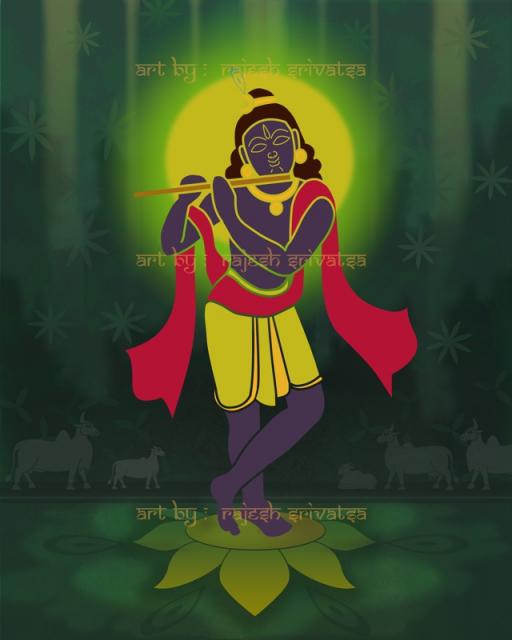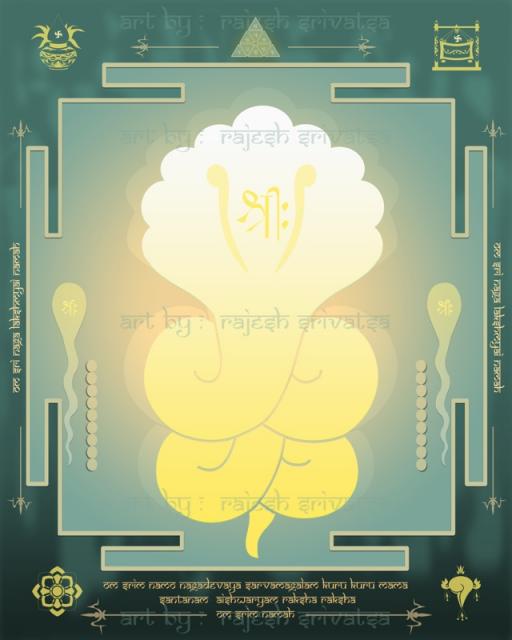PAINTINGS
Digital art pictures from puranic and tantric scriptures by Rajesh Srivatsa
e-mail: rajesh@detna.com
October 2009
The Divine
This is an attempt by Rajesh Srivatsa to create spiritual environment through the digital art pictures.
The symbols, colors and details used
in the images are taken from both the puranic and tantric scriptures. But
not direct adaptions of those details.
Shabda mantras and Beeja mantras
shown in Devanagari and English texts are selected very carefully. Because
it's well known that energy created from the sounds of these mantras may
affect in both ways - good or evil. In some pictures mandalas are shown.
Mandals are nothing but a symbolic
map of universe. Sometimes they may represent all 14 Lokas as in
'Srichakra'
sometimes it may represent any single loka like in Ganesh yantra.
Sometimes
it may represent palace of the deity or may be just a place arrangement.
Most of these maps contain bhupuras (outer border with openings at
4 directions), circles, lotus, and six cornered figure and a triangle
inside it and finally a dot at the centre inside that triangle.
Ganesha

Ganesha: According to Gaanapatya
tantric cult Ganesha is the Parabrahmathe supreme energy. When there was
nothing before the formation of universe the space was filled with
a sound 'Gam'. Gam is the moola bijakshara of Ganesha. Parabrahma
emerged
in the form of Ganapathi with ultimate cosmic sound 'OM'. ( Gam which
initiates
everything and we can recall Ganesha is to be worshiped first before any
activity even before the worship of other gods.) With his emergence,
all the
obstacles were removed for the creation of the world. This picture
illustrates
emergence of Ganesha from 'Gam' Mandala with Omkara in his hands and
stomach.
He is shown in red color. In Yoga the first chakra of the kundalini is
Mooladara Chakra which is in red color at the bottom end of the back
bone
of our body and Ganesha is the God of Mooladhara Chakra and also in
Ganpathiatharvasheersha
it was said that Ganesha is 'Rakhavarna' (deep red or blood red
literally)
(red is one of the three primary colors) and green cactus like textures
around him are symbolic of obstacles getting removed with the emergence
of Ganesha.
Bhadra
Ganesh

Bhadra Ganesh: Here Bhadra means
Mangal. Ganesh is the mangalaroopi with concerts Siddhi Devi and Riddhi
Devi. Kshema and laabha are the two sons of Ganesh (however many holy
texts
says he is unmarried) according to Vijayagama shipla samhitha, Bhadra
Ganesh
has only two hands, red in color, dressed with red clothes, pictures
drawn
from ashtagandha (eight kind of aromatic substances) along his trunk,
having
his own tusk (Shubh) piece in the right hand and lotus (Laabh is also
lotus,
symbol of Lakshmi) in the left hand, brihath-udhara means large stomach,
riding on a car pulled by two rats after a satisfied meal, he is in
a happy mood and 'Shantha Netra' very calm eyes holy spirits showering
flowers on his path, shown symbolically. Dharshan of Bhadra Ganesh in
the morning results in a joyful whole day.

Surya

Shiva

Varaha

Krishna / Murali Mohana
Narasimha

Narasimha: One of the most celebrated
incarnations of lord Vishnu. Lord revealed himself as the ferocious Man-Lion
bursting out of pillar. Though he is ferocious he is dearest to his
devotees, his hands in the abhaya (protection) and varada (boon bestowal)
gestures. Kshroum beejakshra of Narasimha, here Narasimha has been shown
as bursting out from the pillar with cosmic light surrounding him which
is symbolised by mandala or six cornered shape with sound Kshroum. Though
lord has lion face most of puranic details describes him as 'Shwetha Varna'
white in color. But it is enclosed by burning sparks of fire that emanate
from his body itself. Display of Narasimha figures in homes removes insecure
feelings from the minds of people living there and destroy evil, black
magic powers from the place.
Agni
Durga / Jwalaa Devi

Agnidurga / Durga is worshiped all
over the country as a great Mother. She is the Goddess of energy. In Vedic
period she was associated with 'Agni', the Fire God and also with Sun God.
She is Soorya Mandala Madyastha, means residing in Soorya mandala. She
is the Mahamaya (Great Illussion) power of Vishnu and Shakti (energy) of
Shiva. She is the power which destroys darkness (tamoharini) here she is surrounded
by panchagni (5 flames) holding weapons discus, conch (weapons of Vishnu)
a trident (weapon of Shiva and Mangalagni (fire which brings good fortune).
Karyasiddhi
Hanuman

Karyasiddhi Hanuman: A rare figurative
form of Hanuman (Bhaktha Anjaneya, Veeranjaneya are very common figurative
forms) worshiped in some parts of Karnataka. Shilpa shastras give details
as Hanuman returning from Lanka after he found Sita in Ashoka Van. He is
sitting before Sri Ram obediently but proudly after his completion of great
task. He is reporting all details to Ram and showing him 'Choodamani' (pearl
bindiya on her forehead given by her father as a gift) got from Sita for
exchange of Sri Rama's ring. Sugreeva king of Vanaras allowed all the monkeys
to loot the royal garden (symbolically shown with mango and coconut bunches)
to celebrate this happy occasion which is shown as monkeys dancing around
Hanuman in the figure. Ham is the one of Hanuman's beeja mantras. It is said
that the way to get Hanuman's blessings to finish great tasks is by worship
of Hanuman in the form of 'Karyasiddhi Hanuman'.
Naga

Naga: Snakes are considered as holy
spirits and is associated with most of the gods in Hindu religion. Nagas
are responsible for the security of the hidden treasures Shankha nidhi and
Padma nidhi shown at the bottom of the mandala. Naga worship removes obstacles
and bad fortunes for marriages and in having descendants. Usually 9 main nagas
are worshiped in practice Anantha , Kalinga, Vasuki, Karkotaka, Padma,
Shesha , Dritharastra and Shanka. At the top Navanaga mandala is shown
with all beejaksharas. Langula 'plounge weapon' for protection are shown in
all directions. In some parts of the country nagin's with eggs along with
nagas are worshiped, as in puja agamas, if nagas are to be worshiped in pictures
- they should have white and yellow color.
Paintings - Links to the various sections
Information
Display of art works
Folk / Regional / Traditional Paintings
Contemporary Artists
Traditional / Art and Craft / Cartoons
|